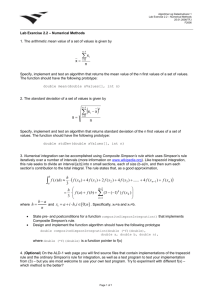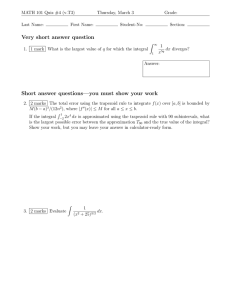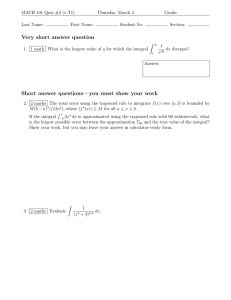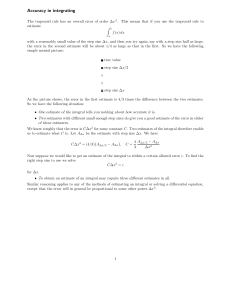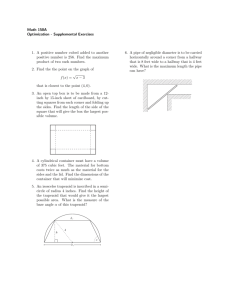MITOCW | MIT18_01SCF10Rec_49_300k
advertisement
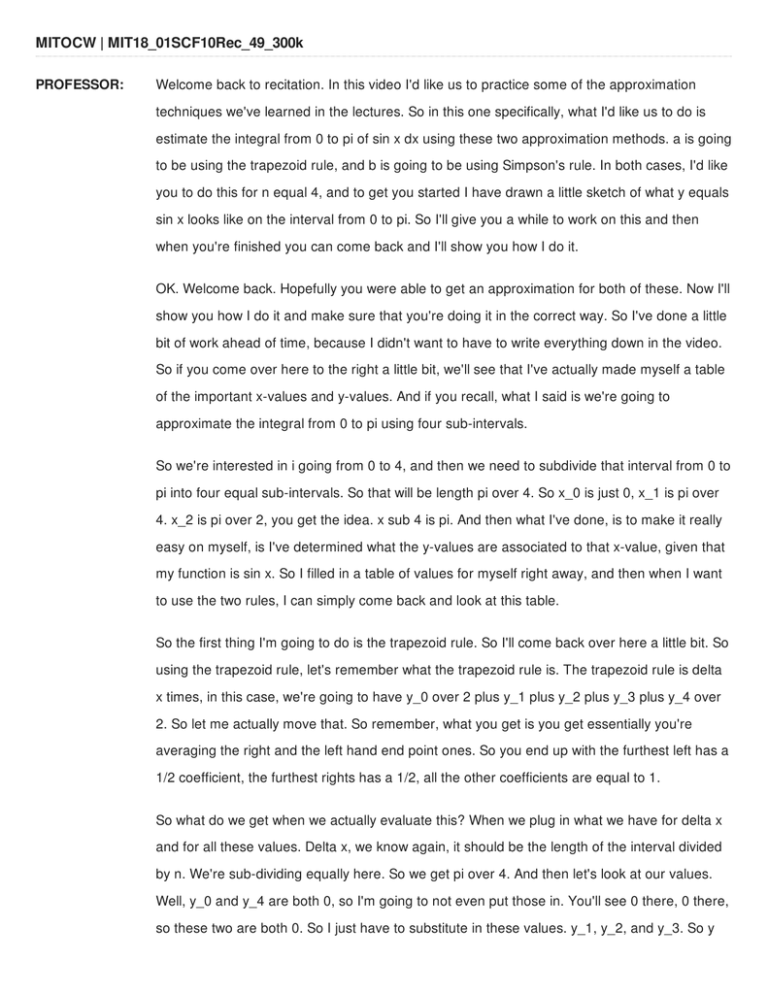
MITOCW | MIT18_01SCF10Rec_49_300k PROFESSOR: Welcome back to recitation. In this video I'd like us to practice some of the approximation techniques we've learned in the lectures. So in this one specifically, what I'd like us to do is estimate the integral from 0 to pi of sin x dx using these two approximation methods. a is going to be using the trapezoid rule, and b is going to be using Simpson's rule. In both cases, I'd like you to do this for n equal 4, and to get you started I have drawn a little sketch of what y equals sin x looks like on the interval from 0 to pi. So I'll give you a while to work on this and then when you're finished you can come back and I'll show you how I do it. OK. Welcome back. Hopefully you were able to get an approximation for both of these. Now I'll show you how I do it and make sure that you're doing it in the correct way. So I've done a little bit of work ahead of time, because I didn't want to have to write everything down in the video. So if you come over here to the right a little bit, we'll see that I've actually made myself a table of the important x-values and y-values. And if you recall, what I said is we're going to approximate the integral from 0 to pi using four sub-intervals. So we're interested in i going from 0 to 4, and then we need to subdivide that interval from 0 to pi into four equal sub-intervals. So that will be length pi over 4. So x_0 is just 0, x_1 is pi over 4. x_2 is pi over 2, you get the idea. x sub 4 is pi. And then what I've done, is to make it really easy on myself, is I've determined what the y-values are associated to that x-value, given that my function is sin x. So I filled in a table of values for myself right away, and then when I want to use the two rules, I can simply come back and look at this table. So the first thing I'm going to do is the trapezoid rule. So I'll come back over here a little bit. So using the trapezoid rule, let's remember what the trapezoid rule is. The trapezoid rule is delta x times, in this case, we're going to have y_0 over 2 plus y_1 plus y_2 plus y_3 plus y_4 over 2. So let me actually move that. So remember, what you get is you get essentially you're averaging the right and the left hand end point ones. So you end up with the furthest left has a 1/2 coefficient, the furthest rights has a 1/2, all the other coefficients are equal to 1. So what do we get when we actually evaluate this? When we plug in what we have for delta x and for all these values. Delta x, we know again, it should be the length of the interval divided by n. We're sub-dividing equally here. So we get pi over 4. And then let's look at our values. Well, y_0 and y_4 are both 0, so I'm going to not even put those in. You'll see 0 there, 0 there, so these two are both 0. So I just have to substitute in these values. y_1, y_2, and y_3. So y sub 1 is root 2 over 2, y sub 2 is 1, and y sub 3 is root 2 over 2. So I should get root 2 over 2 plus 1 plus root 2 over 2. And if you want to simplify a little bit, you can do that. Root 2 over 2 plus root 2 over 2, is root 2. Hopefully you got something that looked like this. And I gotta tell you at this point, I'm stopping. Because I don't want to bother to simplify any more than this. But the main point is, I want to make sure we understand, once we have this method how to substitute everything in. So this first one was just using the trapezoid rule to approximate the integral. Now, what does that actually mean in terms of the graph? Let's go back to the graph and let's look at what that actually means. I'm going to get another color for this. So in the case of the trapezoid rule, what that means, I'm sub-dividing the interval like this and the trapezoid rule, remember, connects the two y-values. Consecutive y-values here. And it's giving you the area of each of those. So we found the blue, we found the blue shaded area with the trapezoid rule. So just to recall, that's actually what we did. This is a fairly good approximation, looks like in this case, of what the actual integral is. So now let's do Simpson's rule. And I'll come over to the right of the table to do Simpson's rule. Now notice I can do Simpson's rule because n is an even number. I have to have n even in order to do Simpson's rule. So just to remind us what Simpson's rule is, Simpson's rule is delta x over 3 and then I have these funny coefficients, which at some point we will explain. I have a 1 in front of y_0, a 4 in front of y_1, 2 in front of y_2, a 4 in front of y_3, and a 1 in front of the y sub 4. So that's exactly the coefficients for Simpson's rule. And you saw in class why this is a 2. You'll see in another recitation video why we end up getting the 1, 4, 1. And those two things add up, 1, 4, 1; 1, 4, 1. And where the 3 comes from. We'll show all of that in another video. So let's fill in what we have. Well delta x is pi over 4 so I get pi over 4 times 1/3, so I get pi over 12. y_0 is again 0. y_1, come back here, it was root 2 over 2. Root 2 over 2 times 4 is 2 root 2. y_2, if you remember, was 1. So I get 2 times 1 is 2. And then I have the same two values. Because this is a-- this is symmetric about the y_2 value. So I get another 2 root 2, and another 0. So if I simplify all this, I get pi over 12-- oops-- pi over 12 and then I get 4 root 2 plus 2. And so that we can maybe see a little bit more what it, how it compares, we can simplify this a little bit. I'm going to put the 1 in front, 1 plus 2 root 2. Now, if you wanted to actually do a comparison of those two values, and then compare that to the actual integral, you'd want to evaluate the actual integral and then maybe look at what these two are on a calculator. But, I just wanted to make sure we knew how to plug in the y-values and the appropriate delta x to the appropriate formula. So, again, what we were trying to do is estimate the integral for one that we actually know, so we could do some comparison if we wanted. And see how these numerical methods, or these approximations actually work. So we did trapezoid rule, we had the formula up there. We did Simpson's rule and the formula's right here. And when we were doing this, the thing that made it simpler is at the very beginning I made a nice table of values. So when you're solving these types of problems that might be something you want to think about doing right at the very beginning to make things a little simpler for yourself. And I think I'll stop there.

